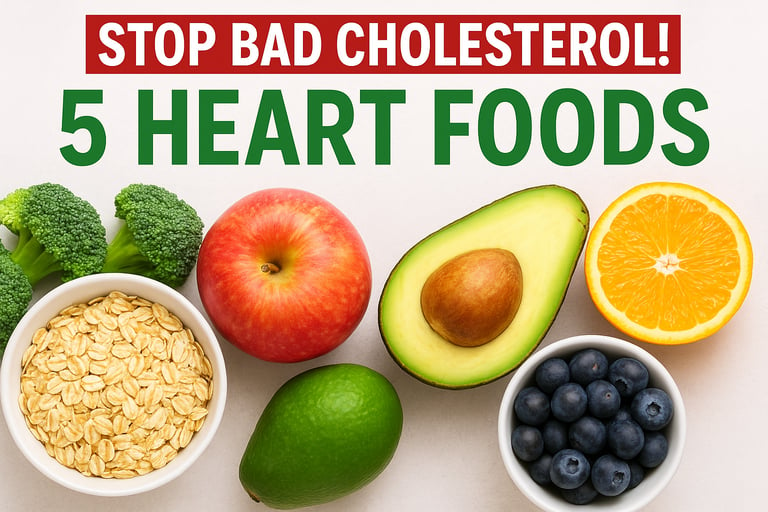✨ Kickstart Your Wellness Journey — Download the Free Detox Guide
5 Foods That Lower Bad Cholesterol Naturally
Discover five powerful, friendly foods, oats, beans, apples, berries, and avocados, that naturally lower LDL cholesterol. Learn how they work, the science behind them, and easy recipes to protect your heart and boost overall health.
BLOG
8/10/20255 min read


5 Powerful Foods That Block Bad Cholesterol Naturally — A Guide to Heart-Healthy Eating
Heart and circulatory diseases remain one of the UK’s leading causes of death, claiming more than 160,000 lives each year, according to the British Heart Foundation. A major contributor to these conditions is high levels of “bad” cholesterol or low-density lipoprotein (LDL) in the blood.
LDL cholesterol can quietly build up inside your arteries over years, forming fatty deposits (plaques) that reduce or block blood flow. This process, known as atherosclerosis, increases the risk of heart attacks and strokes.
The encouraging news? The food you choose to put on your plate every day can make a big difference to your cholesterol levels. Certain foods contain natural compounds that help block the absorption of bad cholesterol, support its removal from the body, and protect your heart from long-term damage.
This article takes you through five of the most powerful cholesterol-fighting foods backed by solid scientific evidence, plus UK-specific shopping tips, meal ideas, and everyday ways to work them into your diet.
Understanding Cholesterol — The Good, the Bad, and the Necessary
Before diving into the superfoods, let’s understand cholesterol itself. Cholesterol often gets an undeservedly bad reputation your body actually needs it. It’s a waxy substance used to build cell membranes, produce hormones, and aid digestion.
There are two main types:
LDL cholesterol (low-density lipoprotein) – the so-called “bad” cholesterol. High levels can lead to plaque build-up in arteries.
HDL cholesterol (high-density lipoprotein) – the “good” cholesterol. It carries cholesterol away from the arteries back to the liver, where it’s broken down and removed.
A healthy balance between LDL and HDL is vital for cardiovascular health. In the UK, NHS guidelines recommend:
Total cholesterol: 5 mmol/L or lower
LDL cholesterol: 3 mmol/L or lower
HDL cholesterol: 1 mmol/L or higher for men, 1.2 mmol/L or higher for women
How Diet Can Reduce LDL Cholesterol
Certain foods work in different ways to lower LDL:
Blocking absorption in the gut – Some foods bind cholesterol in the digestive system so it passes out of the body.
Increasing cholesterol removal – Others encourage the liver to use more cholesterol to produce bile acids, lowering levels in the blood.
Preventing oxidation – Antioxidants protect LDL cholesterol from oxidative damage, which makes it more harmful.
The most effective foods are typically rich in:
Soluble fibre – forms a gel in the gut that traps cholesterol
Plant sterols/stanols – compete with cholesterol for absorption
Healthy fats – monounsaturated and polyunsaturated fats help balance cholesterol
Polyphenols and antioxidants – reduce inflammation and protect artery walls
The 5 UK-Friendly Foods That Block Bad Cholesterol
1. Oats & Barley
Why they work:
Oats and barley are staples in British kitchens, and for good reason. They’re rich in beta-glucan, a form of soluble fibre that forms a gel in the intestines. This gel binds with cholesterol-rich bile acids and carries them out of the body. To replace the lost bile acids, the liver draws more cholesterol from the blood, lowering LDL levels.
Science spotlight:
According to a Cochrane review, just 3g of beta-glucan per day, the amount in roughly a 40g bowl of porridge oats can lower LDL cholesterol by 5–10%.
How to eat them (UK-style):
Start your day with porridge topped with British berries and a drizzle of honey.
Use barley instead of rice in risottos or soups. Pearl barley works brilliantly in traditional broths.
Add oat bran to muffins, bread, or smoothies.
Shopping tip:
Look for whole rolled oats or jumbo oats rather than instant porridge, which can have added sugar.
2. Beans & Lentils
Why they work:
Beans and lentils are budget-friendly, versatile, and an excellent source of soluble fibre. They also provide plant-based protein, which can replace red and processed meats, both linked with higher cholesterol levels.
UK-relevant science:
A study published in the British Journal of Nutrition found that eating one serving of legumes per day lowered LDL cholesterol by around 0.17 mmol/L.
How to eat them in Britain:
Make lentil soup with carrots, celery, and herbs — a winter favourite.
Add kidney beans to chilli con carne (or its veggie equivalent).
Create a Coronation chickpea sandwich filling for a cholesterol-friendly twist on a classic.
Shopping tip:
Tinned beans are convenient, but rinse them under cold water to reduce salt content.
3. Apples & Citrus Fruits
Why they work:
These fruits are rich in pectin, another soluble fibre that binds cholesterol in the gut. Citrus fruits also contain flavonoids, which have antioxidant and anti-inflammatory benefits.
Science spotlight:
Research in The American Journal of Clinical Nutrition found that regular apple consumption reduced LDL cholesterol by around 7%. Grapefruit and oranges showed similar benefits.
How to eat them:
Enjoy an apple as an easy packed lunch snack.
Add orange segments to spinach and walnut salads.
Use lemon zest and juice to brighten fish dishes like mackerel or trout.
Shopping tip:
Seasonal apples like Bramley and Cox’s Orange Pippin are fresher and often more flavourful.
4. Berries
Why they work:
Berries, including strawberries, blueberries, raspberries, and blackberries, are bursting with anthocyanins, antioxidants that protect LDL from oxidation.
Science spotlight:
A Finnish study found that daily berry consumption improved HDL cholesterol and reduced oxidised LDL levels in just eight weeks.
How to eat them:
Top porridge or overnight oats with frozen berries (picked in season, frozen for freshness).
Add fresh strawberries to summer puddings or yoghurt.
Use blueberries in homemade wholemeal muffins.
Shopping tip:
Frozen berries are often cheaper and just as nutritious and they’re available year round in supermarkets.
5. Avocados
Why they work:
Avocados are packed with monounsaturated fats and plant sterols, both known to lower LDL cholesterol. They also contain fibre, making them a triple-threat for heart health.
Science spotlight:
A meta-analysis in the Journal of the American Heart Association concluded that avocado consumption reduced LDL cholesterol significantly when used as part of a balanced diet.
How to eat them:
Smash avocado on wholemeal toast with tomato and black pepper.
Add diced avocado to prawn salads or wraps.
Blend with cocoa powder and a little honey for a heart-healthy chocolate mousse.
Shopping tip:
To ripen faster, place avocados in a paper bag with a banana.
Bonus: Leafy Greens
Although not one of our five main foods, leafy greens like spinach, kale, and collard greens deserve mention. Steaming them boosts their ability to bind cholesterol in the gut.
Friendly serving ideas:
Add spinach to omelettes or pasta dishes.
Use kale in bubble and squeak.
Stir chopped greens into stews in the last few minutes of cooking.
Practical Tips for Eating These Foods Daily
To make it realistic and sustainable:
Breakfast: Porridge with berries and a slice of wholemeal toast topped with avocado.
Lunch: Lentil soup with a side of salad featuring apples or citrus segments.
Dinner: Barley risotto with leafy greens, plus a side of steamed kale.
Snacks: A handful of berries or an apple.
Shopping on a Budget
Buy seasonal produce – British berries in summer, apples in autumn.
Use frozen fruit and veg for affordability and reduced waste.
Bulk-buy oats, barley, and lentils from larger supermarkets or health food shops.
Look for supermarket own brands — they’re often as nutritious as premium versions.
Lifestyle Factors Beyond Diet
The NHS recommends combining a cholesterol-lowering diet with:
At least 150 minutes of moderate activity each week.
Quitting smoking.
Maintaining a healthy weight.
Limiting alcohol to 14 units per week.
Final Thoughts
Small daily changes, like swapping white toast for porridge, adding beans to soups, or topping salads with citrus, can add up to a big difference in cholesterol levels.
Nature provides powerful allies for your heart: oats, beans, apples, berries, and avocados. By making them part of your daily meals, you’re not just eating well, you’re investing in a healthier, longer life.
The Vibe Well
The Vibe Well is your go-to space for natural wellness, faceless health courses, and everyday inspiration to feel your best.
© 2025. All rights reserved.


